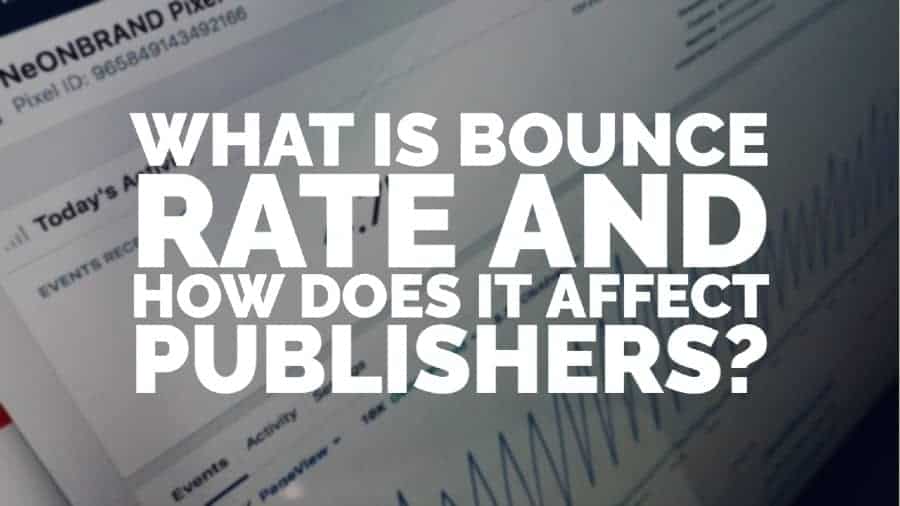
This post was most recently updated on August 16th, 2022
Publishers rely on various metrics to assess the strength and marketability of their website and ad inventory. While publishers may weigh these metrics differently, there is no mistake that many of them are important and should be carefully monitored and optimized. One of these metrics is the bounce rate. To understand the bounce rate, let’s first understand some of the related terms.
The bounce is a session where only a single page was visited. It’s usually caused by a multitude of factors, including page load time, browser compatibility, irrelevant content, and many more. A bounce isn’t necessarily bad. Some sites are expected to have a high bounce rate. This includes sites that are mostly marketing-based (single vertical landing page) or sites that dynamically load content without refreshing the page via AJAX (stock market tickers or weather bulletins with real-time updates). Furthermore, there may also be specific site sections that will have an extraordinarily high bounce rate. Examples of these include:
Here are some ways a session could be regarded as a single page:
Now that we understand what a bounce is and when it is determined, we can easily define the bounce rate. The bounce rate is calculated as the number of single page sessions divided by the total number of sessions. For example, if your blog recorded 5,000 single page sessions in a day with 75,000 total sessions, the bounce rate would be 0.0667 or 6.67%.
The bounce rate has many implications for publishers, and each type of website is affected differently. Here are some of the common ones:
The bounce rate is a significant factor when determining a website’s value. Sites that have a ranking, SEO, or valuation tools like Ahrefs, Majestic, Moz, etc all factor in bounce rate directly or indirectly in their calculations. A good ranking, in particular, is highly sought after and could get a valuable site partnership if well-maintained.
In some instances, the bounce rate can also affect a site’s Google search ranking. Google does not explicitly state that it uses the Analytics bounce rate metric in ranking search pages. It definitely should not because website engagement is not solely dependent on the bounce rate. However, there are some cases where we can assume the bounce rate would affect rankings. For example, If your site is experiencing a high bounce rate for a prolonged period brought about by tech issues, your pages that were previously ranked high would slowly be deranked as a result of crawlers not being able to reach your sitemaps or article pages.
Ad monetization is a standard revenue stream for most sites. With a high bounce rate, websites are likely to get fewer approvals from demand partners because the primary goal of advertisers is getting their ads the maximum exposure. If a site gets approved by specific networks, the CPM or CPC rates would likely be poor. More often than not, the partnership would not last long.
Additionally, sites with high bounce may also have an inversely proportional CTR(clickthrough rate). What this means is that as the bounce rate goes higher, CTR also goes lower. This relationship can be explained if one looks at it from a visitor perspective. If the site ranks high for some keywords in Google, but the visitors do not find the content relevant, they are likely to press the back button and go to the next result, hence a bounce. Now how does it relate to ad monetization? Yes, the site can generate ad impressions for all users who found that irrelevant content. However, it is also very likely that those visitors didn’t give the ads any second thought, given that the content itself was not what they were looking for. This may not be the case for all sites, though.
These are just some of the examples of how the bounce rate could affect ad monetization.
In conclusion, the bounce rate is an important metric, but also rather broad. To make sure your efforts are maximized, be sure to do granular reporting via page or channel segmentation. Besides that, digging into the other Google Analytics sections can also shed some light. Are you struggling with high bounce rates and low ad RPMs? Let MonetizeMore help! We can help you choose the right kind of ads, layout, and more to increase your ad revenue. Sign up to MonetizeMore today!

Kean Graham is the CEO and founder of MonetizeMore & a pioneer in the Adtech Industry. He is the resident expert in Ad Optimization, covering areas like Adsense Optimization,GAM Management, and third-party ad network partnerships. Kean believes in the supremacy of direct publisher deals and holistic optimization as keys to effective and consistent ad revenue increases.
10X your ad revenue with our award-winning solutions.